List of reportedly haunted locations in the Philippines

One of the principal buildings housing internees at the Santo Tomas Internment Camp was the Education building (now the UST Hospital). Shanties and vegetable gardens can be seen near the building and the wall of the university compound is in the background.
There are several reportedly haunted locations in the Philippines. Reports of such haunted locations are part of ghostlore, which is a form of folklore. The entries are alphabetized.
Metro Manila[]
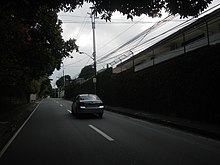
Balete Drive
- Ateneo de Manila University: One of the most prestigious educational institutions of the country, ADMU is claimed by believers to be haunted.[1][2]
- Balete Drive: A major residential avenue in the eastern part of New Manila, Quezon City, Balete Drive is noted as the site of several apparitions of a white lady, who is considered by believers to be the ghost of a teenage girl who was raped and killed by a taxi driver in the 1950s.[2][3][4][5][6]
- Capitol Medical Center: A certain elevator of the hospital was reported to be haunted. Eyewitnesses claimed this off-limits elevator brought them to the basement, which once served as a morgue, instead of bringing them to their intended destination.[7]

Chapel of the Most Blessed Sacrament of DLSU
- De La Salle University: Due to its brutal Second World War-era history, DLSU is reportedly haunted. The university's Chapel of the Most Blessed Sacrament, which is housed inside St. La Salle Hall, witnessed the massacre of refugees and La Sallian brothers who sought shelter inside at the hands of the Imperial Japanese Army. The Bro. Connon Hall that houses the offices of the university's student organizations is reported by believing students to be haunted, by a female student who died after being trapped in the building's now-disused elevator. Other areas with reported paranormal activities are Bro. Andrew Gonzalez Hall, St. Mutien Marie Hall, and St. Joseph Hall.[2][8][9]
- Fort Santiago: This is a historic fortress in Intramuros, Manila, and said by believers to be haunted by ghosts of soldiers and civilian victims killed during World War II.[2][10]
- Malacañang Palace: The official residence and principal workplace of the President of the Philippines is considered by believers to be haunted by numerous ghosts such as those of the former presidents (Manuel Luis Quezón, Manuel Roxas, and Ramon Magsaysay), former presidential aides and attendants, those from the pre-Hispanic era, people who were killed during the Second World War, and a black lady peering out towards Pasig River from a window of the Mabini Hall late at night. Areas of reputed paranormal activities include the Mabini Hall, Heroes Hall, Correspondence Office, New Executive Building, and the Music Room. A large balete tree stands at the main entrance to the Freedom Park (at the grounds of the Malacañang fronting the Administration and Executive Buildings), which was designated as a National Heritage Tree in 2011 but claimed by believers to be the home of a kapre.[11][12][13]
- Manila Central Post Office: The building served as a crucial Japanese garrison during the Second World War, according to historian Gerard Lico. He speculated that as their last stronghold, the Japanese soldiers may have met their deaths there. Believing employees, past and present, claim of various residual hauntings from wartime period in the historic building. It was featured in the 2021 Halloween special of GMA Network's telemagazine program Kapuso Mo, Jessica Soho.[14]
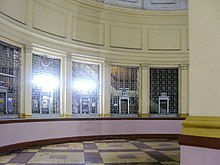
A section of the interior of Manila Central Post Office
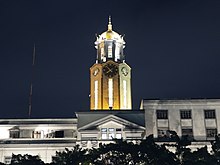
Manila City Hall at night
- Manila City Hall: Believing city hall employees claim of wandering specters after 6:00 p.m.. Paranormal experts investigated in the area confirmed poltergeist activities, residual hauntings from Japanese-era ghosts and a woman believed to have died in the premises during World War II. Most of the hauntings are concentrated in the clock tower of the city hall.[15] Believers also indicate its eerie casket-like shape when viewed from above (although some contend it resembles the shield of the Knights Templar).[2][6][16]
- Manila Film Center: A major component of the Cultural Center of the Philippines, the facility was the site of a construction accident. Construction was rushed as the first Manila Film Festival neared, and on November 17, 1981 the scaffolding holding the fourth floor gave way, sending workers down to be entombed in the quick-drying cement. Project supervisor Betty Benitez ordered the work to continue, instead of retrieving the bodies of the dead workers, for fear of not meeting the deadline. Paranormal activities began on the day the construction resumed, with the deceased workers appearing themselves to their living colleagues. Usherettes who were invited on January 18, 1982, the day of the film festival, claimed to have felt cold presences and smelled mysterious odor in the backstage. Benitez herself perished in a bizarre car accident months after the events. Believers claim the spirits of the dead workers continue to indicate their presence in the theater.[2][6][17][18] The facility, formerly abandoned due to its reputation, is now in use after restoration works.
- Miriam College: Believing students claim of the ghost of a nun in the ladies' restroom at the 2nd floor of the Caritas Building.[19]
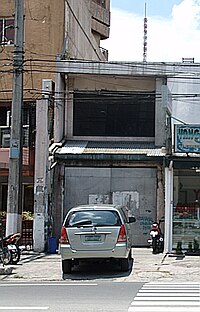
Ozone discothèque as it appeared in 2008.
- Ozone Disco: A former discothèque in Quezon City that was the site of the worst fire in the Philippine history. The 1996 fire killed at least 162 people and injured at least 95.[20] The discothèque building was demolished in 2015, and the site is now presently occupied by GoodAh!!!, a 24-hour diner, co-operated by Boy Abunda, and paranormal activities in the area were claimed to have greatly minimized ever since.[16][21][22][23]
- Philippine National Bank – Pasay branch: The fifth floor of this Pasay branch of PNB at Roxas Boulevard was used as a morgue for the 16-to-25 victims of a fire at the Regent of Manila hotel on February 13, 1985. Exorcisms were conducted on the said floor at the requests of previous occupants because of frequent paranormal activities.[2]
- Polytechnic University of the Philippines: The institution's Claro M. Recto Hall houses a small theater where the backstage rooms are the hot spots of an apparition of a burnt entity as confirmed by theater director and professor Segundo "Dodie" Dizon. The College of Engineering is also a paranormal hot spot where not only a ghost of a child and a white lady are said to appear but also the spirit of a deceased professor frequents the halls. ABS-CBN telemagazine program Magandang Gabi... Bayan featured the paranormal case of PUP in its 2005 Halloween special.
- Starmall Alabang: It is situated on the former site of the Alabang Cemetery. Believers claim ghosts haunting its theaters.[2][6]
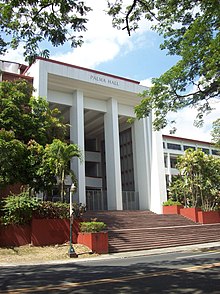
UP Diliman Palma Hall
- University of the Philippines Diliman Campus: Its long history is said to be the reason of its alleged hauntings. Some of the areas of reported paranormal activity include the College of Music, the Vanguard Building, and Palma Hall. Guerrero Theater, which is housed in the second floor of Palma Hall, supposedly hosts the spirit of a young theater actress who committed suicide after a newcomer obscured her recognition.[2][24]
- University of the Philippines Manila Campus: The campus is one of the witnesses of World War II.
- University of Santo Tomas: Is reported by believers to be haunted, due to its long history that spans from the Spanish era. Santo Tomas also served as an internment camp during the Second World War wherein many of the prisoners of war were "enemy aliens", mostly Americans, living in the Philippines. Many prisoners died of starvation, illness, and other causes. The university is also a witness to unlucky students resorting to suicide, such as the female ghost in one of the ladies' restrooms in the Main Building.[2][10][16] Former UST Rector Magnificus Rolando de la Rosa confirmed in an interview about an alleged mass grave located near the UST museum.
Independent cities (highly urbanized cities)[]
Baguio[]
Baguio, the largest city of northern Luzon and a noted tourist destination, is said to be highly haunted. There are several haunted locations scattered throughout the city, such as cemeteries, old hotels, and other sites where structures used to stand until the 1990 Luzon earthquake destroyed them, injuring and killing the people inside. The city was also the site of some of the most brutal atrocities committed during World War II.[25][26][27] Such haunted locations include the following:
- Casa Vallejo: The oldest hotel in the city, it was built in 1909 to house key personnel of the Bureau of Public Works, before becoming a hotel in 1923. It is alleged that it served as a detention center for the German prisoners of war in 1917.[26]
- Dominican Hill Retreat House: Commonly called Diplomat Hotel, it was originally a seminary and later converted into a hotel. Situated atop the Dominican Hill, it has been considered as the city's most haunted location as it was the site of numerous atrocities committed by the Japanese forces during World War II. Priests, nuns, and refugees who sought refuge from war were tortured, raped, and decapitated by the Japanese forces.[21][26][27][28]
- Hotel Nevada: One of the city buildings destroyed in the 1990 Luzon earthquake. Dion Fernandez, a medium, claimed the spirits of the earthquake fatalities "have mercifully moved on".[29]
- Hyatt Terraces Hotel: A 12-storey hotel that was destroyed in the 1990 Luzon earthquake. The destruction killed at least 50 people. Believers claim ghosts of those perished in the earthquake wandering the vacant site. Like the case of Hotel Nevada, Fernandez claims all spirits have left the area.[26][27][29]
- Japanese Tunnels: A labyrinth of underground tunnels that were built by the Imperial Japanese Army.[30]
- Laperal White House: Also known as the Laperal Guesthouse, it was built by Roberto Laperal in the 1930s as a vacation home for his family. During World War II, the Japanese soldiers occupied the house and used it as a garrison, where they reportedly committed various atrocities, such as torturing and killing suspected spies working for the United States and their allies. Purchased in 2007 by one of the prominent Filipino-Chinese business magnate billionaires, Lucio Tan, it now serves as a museum of locally-made Filipino artworks based on bamboo and wood.[10][31][27]
- Loakan Road: The access road to Loakan Airport, believers claim of a female vanishing hitchhiker (supposedly a rape victim) wandering the area. A tree that formerly stood in the middle segment of the road was the reputed home of the specter, and believers claim the DPWH employee who cut it down met his death by another falling tree.[26][27][29]
- Philippine Military Academy: The military school of the Armed Forces of the Philippines (AFP) is reportedly haunted by various ghosts, including a faceless cadet not in proper attire roaming around the institution at night.[32]
- Teacher's Camp: First established as a training site by American teachers (Thomasites), it is now training center for teachers in the country. It is alleged that it was built on the site of a battlefield of the former indigenous residents.[10][26][27]
Dominican Hill Retreat House
Laperal House

Teacher's Camp
Cebu City[]

Museo Sugbo, formerly a prison (as "Cárcel de Cebú")
- Casa Gorordo Museum: It previously served as the family residence of Juan Gorordo, the first Filipino bishop of the Philippines. He died in the master's bedroom in 1934. Believers, however, claim of a female specter who is said to be the ghost of one of Gorordo's spinster sisters.[33][34]
- Cebu Normal University: The university served as a garrison during the Japanese era.[34]
- Escario Pension House: A four-storey building located on Escario Street. Believers claim that it is haunted; stories maintain that monthly a worker perished during its construction.[21][33]
- Fort San Pedro: This historical military fort is claimed by believers to be haunted.[34]
- Museo Sugbo: It is claimed by believers to be haunted, as it was formerly a prison during the Spanish colonial period (as the Cárcel de Cebú) and the Japanese occupation of the Philippines.[34]
- Villalon Mansion: Located at the Capitol Site, it was once the residence of an affluent Cebuano family. Believers now claim of paranormal activities in the now-off-limits site, including a white lady.[21][33][34]
Davao City[]
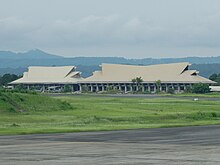
Davao International Airport's former terminal buildings, which still stand today.
- Ateneo de Davao University – Matina campus: The campus is situated on site of a wartime-era Japanese airfield. Believing students, faculty, staff, and security personnel claim of ghosts of Japanese soldiers and of deceased students haunting the campus.[35]
- Department of Interior and Local Government (DILG) regional office: Believers claim this location is haunted by the kapre. Balete trees filled the area before being occupied by the residents, with the regional office of DILG as the present occupant.[35]
- Francisco Bangoy International Airport: The former terminals of Davao City's main airport in Sasa district is now the home of several homeless families. Those believing occupants claim it is haunted by the deceased victims of the March 2003 bombing that killed 21 people.[36]
- Palm Drive: A short road in Buhangin district whose south end is to the west of SSS Bajada and Southern Philippines Medical Center. Believers claim it is haunted by a brown lady said to be a housemaid of one of the residences along the street who was murdered during a robbery attempt.[35]
- Si residence: The old residence of Si family at Champaca Street is claimed by believers to be haunted. Contrary to popular belief that they were massacred, however, the family moved to Manila in the mid-1990s.[35]
- Talomo Beach: A row of retreat houses along the said beach are said by believers to be haunted by children who drowned along the shores of the beach.[35]
Iloilo City[]
- Central Philippine University: Said by believers to be haunted due to the atrocities committed by the Japanese in the place during World War II. Many Americans who founded the university were killed by the Japanese troops.[37]
Provinces[]
Bulacan[]

Bahay na Pula in 2014
- Bahay na Pula (or Ilusorio Mansion): A World War II site in San Ildefonso, which the Imperial Japanese Army used as their barracks and became a place where so-called local comfort women were forced to work.[31][38][39] It was demolished in 2016 due to a feuding internal conflict between the current members of the Ilusorio family.[40]
Cavite[]
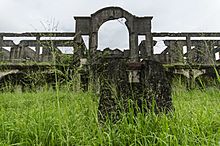
Ruins of Corregidor's hospital, where sounds of footsteps and normal hospital activities have been heard.

Malinta Tunnel, Corregidor
- Corregidor: Situated at the entrance of Manila Bay, this historic island is located near the southern tip of Bataan, though it is administered by Cavite City of the province of Cavite.[41] Corregidor played a major role during World War II, during the invasion and liberation of the Philippines from Japanese forces. The Malinta Tunnel was first used as a storage facility of the U.S. Army during World War II, but was later converted into a hospital where injured soldiers were treated. Shadows, unexplainable noises, and even sudden draft as well as temperature changes have been reported to manifest in the tunnel.[10][16]
Cebu[]
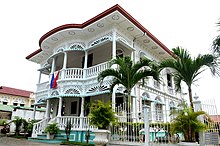
Carcar City Museum
- Carcar City Museum: A 2-storey museum in Carcar showcasing cultural items of the city. Originally established in 1929 as a dispensary to serve the people in distant areas, it was later converted into a museum in 2008. According to local historians, the building during World War II served as torture facility by the Japanese forces in which suspected supporters of the guerrillas were drowned to their deaths at the now-deserted swimming pool.[42]
- Lambusan Public Cemetery: Located in Barangay Lambusan, San Remigio, it is situated in one of the poorest areas of the northern sector of the province. Several of the remains of the deceased were reportedly piled in a common area, as their families and relatives had no more enough money to pay for the yearly rent of the tombs. Ghost sightings in the cemetery have been reported by believers.[21][33]
La Union[]
- Pindangan Ruins (San Fernando, La Union).[43][44]
Laguna[]
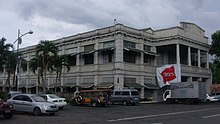
The Baker Memorial Hall of the University of the Philippines Los Baños
- University of the Philippines Los Baños Campus: A witness to the Second World War and the Japanese occupation. The Baker Memorial Hall was used as an internment camp of around 2,500 American and allied POWs and civilians 1943–1945 and headquarters for the Imperial Japanese forces stationed in Los Banos, Laguna. Believers claim of garrotted ghosts in the building. Other areas of claimed paranormal activities are the Men's Dormitory, Main Library, Student Union Building, a footbridge near the UPLB CEAT (destroyed by Typhoon Milenyo in 2006), and Pili Drive.[10][45]
Negros Occidental[]
- Balay Negrense: Also known as Victor Gaston Ancestral House, it is a heritage site and a museum in Silay that was the home of a late-19th century sugar baron. Believing visitors claim of paranormal activities during their visits to the museum.[28]
Negros Oriental[]
- Silliman University: A prestigious Presbyterian institution located in Dumaguete, the institution is reported to be haunted. It was used as a station for Japanese forces during the Second World War. Notable haunted structures include the Katipunan Hall as well as three dormitory buildings; Edith Carson Hall, Channon Hall, and Doltz Hall. Channon Hall was used by the Japanese Kempeitai as their headquarters and torture chamber while Katipunan Hall, built and opened in 1916, originated as Dumaguete Mission Hospital and acted as the main hospital of the university as well as the general hospital of the entire Dumaguete area and its border towns.[46]
Pampanga[]
- Clark Air Base Hospital: Considered as the most haunted location in the Philippines, as it served as an asylum to the wounded (and dying) American soldiers during the Second World War and the subsequent Vietnam War. Ghost Hunters International visited the hospital in 2009, and confirmed the paranormal activities in the site. It is said to believe that people who visit the hospital and sleep within 8 hours after the visit, experience nightmares and intense lucid dreaming for a week.[16][47][48]
Quezon[]
- Herrera Mansion: Also known as the Old Stone House, it is widely considered the oldest house of Tiaong, Quezon. It was designed by Tomás Mapua in 1920. Its original owners were Isidro and Juliana Herrera, but has been abandoned for many years ago and is now deteriorating due to decades of disuse. Believers claim of ghosts from the Japanese era.[10][31][49]
- Mount San Cristobal: A mountain located in the municipality of Dolores. Believing natives claim that it emanates negative energy. It is the so-called 'evil' foil to the holy Mount Banahaw nearby.[50]
Siquijor[]
- Siquijor: An island-province in Central Visayas, has been commonly associated with mystic traditions that the island's growing tourism industry capitalizes on. Its ties to faith healers and sorcery attracts and repulses visitors at the same time.[51]
See also[]
- Ghosts in Filipino culture
- List of reportedly haunted locations
- Philippine mythical creatures
References[]
- ^ "Spooky school stories: Ateneo edition". Rappler. November 2, 2013. Retrieved July 31, 2016.
- ^ a b c d e f g h i j CNN Philippines Life Staff (October 28, 2016). "I see dead people: 10 haunted places around Metro Manila". CNN Philippines. Retrieved November 4, 2017.
- ^ "Myths Surrounding Balete Drive". Philippines Guide. Retrieved November 14, 2010.
- ^ Yap, Dj (November 1, 2005). "Balete may be official "haunted" site". Philippine Daily Inquirer. Retrieved April 18, 2012.
- ^ Dianne De Las Casas; Zarah C. Gagatiga (September 30, 2011). Tales from the 7,000 Isles: Filipino Folk Stories. ABC-CLIO. pp. 119–. ISBN 978-1-59884-698-0. Retrieved April 18, 2012.
- ^ a b c d Bolando, AJ (October 29, 2013). "5 'creepiest, scariest' places in Metro Manila". The Philippine Star. Retrieved July 30, 2016.
- ^ "Top 10 Scariest Spots in Metro Manila". Spot.ph. October 30, 2009. Retrieved October 22, 2021.
- ^ "Spooky school stories: La Salle edition". Rappler. November 2, 2013. Retrieved July 31, 2016.
- ^ "Haunted campus series: Spine-chilling stories from De La Salle University". ABS-CBN News. October 25, 2017. Retrieved November 2, 2021.
- ^ a b c d e f g Laureta, Isabelle (October 18, 2016). "17 Haunted Places In The Philippines That Aren't For The Faint Of Heart". BuzzFeed. Retrieved November 4, 2017.
- ^ Gita, Ruth Abbey (November 1, 2016). "Are ghosts really haunting Malacañang?". SunStar. Retrieved November 4, 2021.
- ^ ""Malacañan Palace Prowlers: Ghosts, elementals, and other phantasmagoric tales"". Presidential Museum & Library. Archived from the original on August 25, 2013. Retrieved June 16, 2013.
- ^ "'Marcos also saw ghosts in Malacañang'". ABS-CBN News. July 19, 2016. Retrieved November 2, 2021.
- ^ "Hauntings at the Manila Post Office: 6 staff members recall their hair-raising experiences". GMA News. October 31, 2021. Retrieved November 2, 2021.
- ^ "Paranormal expert Ed Caluag investigates Manila City Hall's strange occurrences". GMA News. October 28, 2018.
- ^ a b c d e Ramoran, Carol (October 29, 2013). "Ghost hunting in the PH? Here are 7 places". Rappler. Retrieved July 30, 2016.
- ^ "The Manila Film Center mystery: A ghostly place or an urban legend?". Sidetrip with Howie Severino. November 1, 2005. Archived from the original on June 3, 2008. Retrieved November 14, 2010.
- ^ De Guzman, Nicai (November 7, 2019). "The Mysterious Curse of the Manila Film Center". Esquire Philippines. Retrieved October 28, 2021.
- ^ Smitten, Get (October 31, 2015). "20 Most Haunted Places in the Philippines – Page 19 of 20". PumpDown. Retrieved August 7, 2016.
- ^ Vanzi, Sol Jose (March 12, 2001). "LIGHT SENTENCES FOR OZONE DISCO OWNERS". Newsflash. Philippine Headline News Online. Retrieved January 29, 2008.
- ^ a b c d e Galan, Daniel Drake (November 1, 2015). "Haunted places". The Philippine Star. Retrieved November 15, 2017.
- ^ Fernando G. Sepe, Jr. (February 17, 2015). "LAST LOOK: Ozone Disco". ABS-CBN News. Retrieved April 14, 2016.
- ^ Llanera, Melba (October 13, 2016). "Remember the former Ozone Disco? It's now a food chain owned by Boy Abunda". Philippine Entertainment Portal. Retrieved October 13, 2016.
- ^ Occenola, Paige (November 2, 2013). "Spooky school stories: UP Diliman edition". Rappler. Retrieved July 31, 2016.
- ^ Cabreza, Vincent (October 28, 2007). "Horror means profit". Philippine Daily Inquirer. Retrieved February 19, 2008.
- ^ a b c d e f Palma, Renzelle Ann (October 23, 2013). "Top 5 Baguio Haunted Spots". Choose Philippines. Find. Discover. Share. ABS-CBN Corporation. Retrieved December 12, 2016.
- ^ a b c d e f Vince (October 23, 2014). "Five Haunted Places In Baguio City". LakbayBaguio. Retrieved December 12, 2016.
- ^ a b Lunas, Bernadette (October 29, 2016). "Scary spots in the Philippines". Manila Standard Mobile. Retrieved October 28, 2021.
- ^ a b c "Baguio's urban legends revisited". SunStar. October 31, 2016. Retrieved October 26, 2021.
- ^ Monzon, Alden (October 30, 2020). "Tales of WWII-era Japanese ghosts persist in Philippines". ABS-CBN News. Retrieved October 26, 2021.
- ^ a b c Gloria, Gaby (July 7, 2017). "Conjuring the horrific histories of Philippine haunted houses". CNN Philippines. Retrieved November 4, 2017.
- ^ Balana, Cynthia D. (October 30, 2016). "'Even brave troops are afraid of ghosts!'". Philippine Daily Inquirer. Retrieved October 26, 2021.
- ^ a b c d Piccio, Belle (November 1, 2014). "5 Haunted Places in Cebu Perfect for Ghost Hunting". Choose Philippines. Find. Discover. Share. ABS-CBN Corporation. Retrieved November 13, 2017.
- ^ a b c d e Abayon, Crischellyn D. (October 28, 2016). "5 hair-raising places in Cebu City". SunStar. SunStar Publishing, Inc. Retrieved November 13, 2017.
- ^ a b c d e "Haunted Spots in Davao". Choose Philippines. Find. Discover. Share. ABS-CBN Corporation. October 29, 2013. Archived from the original on November 15, 2018. Retrieved November 12, 2013.
- ^ "Haunted airports, coffins for the living in southern PHL?". GMA News. GMA Network. October 27, 2011. Retrieved November 30, 2017.
- ^ Albay, Rhick Lars Vladimir (October 28, 2017). "CPU most haunted?". Panay News Philippines. Retrieved November 12, 2017.
- ^ Doyo, Maria Ceres (January 28, 2016). "Remembering the 'Bahay na Pula'". Philippine Daily Inquirer. Retrieved July 19, 2016.
- ^ Smitten, Get (October 31, 2015). "20 Most Haunted Places in the Philippines". PumpDown. Retrieved August 7, 2016.
- ^ Edgar Allan M. Sembrano (August 15, 2016). "Ilusorio house, symbol of Japan's comfort women in PH, demolished". Philippine Daily Inquirer.
- ^ Layug, Benjamin (May 10, 2015). "Ten things you may not know about Corregidor". BusinessMirror. Retrieved November 15, 2019.
- ^ "Ed Caluag searches Carcar City museum". GMA News. GMA Network Inc. October 28, 2019. Retrieved November 15, 2019.
- ^ Pastor, Pam (October 26, 2013). "Spooky places in the Philippines". Philippine Daily Inquirer. Retrieved July 31, 2016.
- ^ Smitten, Get (October 31, 2015). "20 Most Haunted Places in the Philippines – Page 14 of 20". PumpDown. Retrieved August 7, 2016.
- ^ Ordoñez, Maria Isabella; Levita, Jerico; Wy, Mille Graziella Lisse (October 31, 2018). "Spooky school stories: UP Los Baños edition". Rappler. Retrieved November 3, 2021.
- ^ Cabristante, Raffy (October 31, 2015). "The ghosts of Silliman University". GMA News. GMA Network.
- ^ "Visit if you dare: The 5 most haunted places in the Philippines". Journal Online. January 13, 2015. Retrieved August 14, 2016.
- ^ "Haunted Clark Air Base hospital in new TV documentary". Yahoo! OMG. Retrieved August 20, 2013.
- ^ Smitten, Get (October 31, 2015). "20 Most Haunted Places in the Philippines – Page 2 of 20". PumpDown. Retrieved August 7, 2016.
- ^ Henares, Ivan (September 23, 2007). "Mt. Cristobal (1,470+)". PinoyMountaineer. Retrieved August 14, 2016.
- ^ Bolido, Linda (October 24, 2004). "Who's afraid of Siquijor?". Philippine Daily Inquirer. Archived from the original on January 25, 2005.
Categories:
- Philippines-related lists
- Reportedly haunted locations in the Philippines
- Lists of reportedly haunted locations


